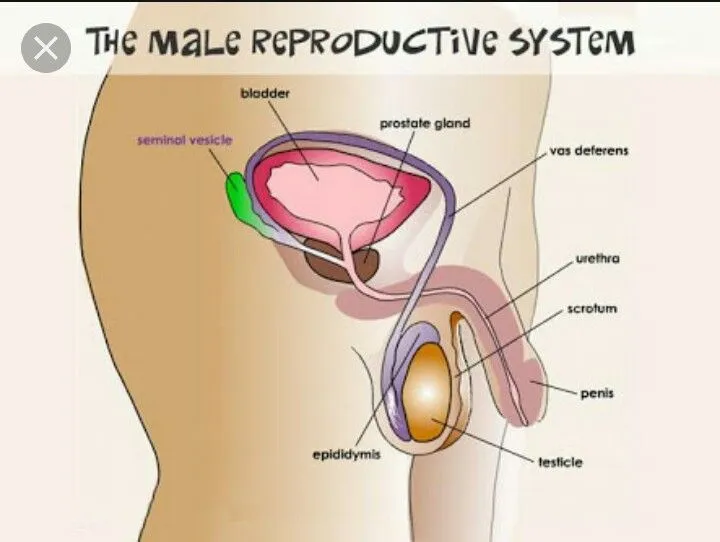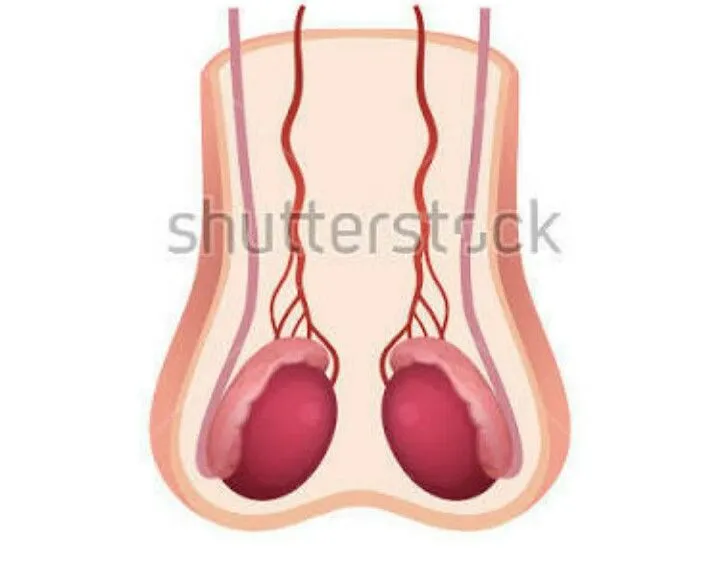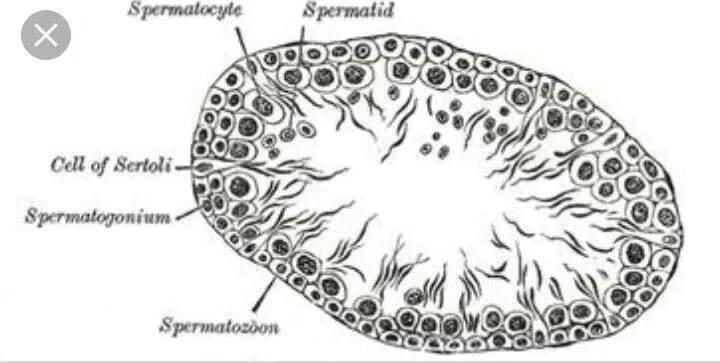Source
The human male reproductive system is a series of organs located outside of the body and around the pelvic region of a male that contribute towards the reproductive process. The primary direct function of the male reproductive system is to provide the male gamete or spermatozoa for fertilization of the ovum.
The major reproductive organs of the male can be grouped into three categories:
The first category is sperm production and storage. Production takes place in the testes which are housed in the temperature regulating scrotum,immature sperm then travel to the epididymis for development and storage.
The second category is the ejaculatory fluid producing glands which include the seminal vesicles,prostate,and the vas deferens.
The final category are those used for copulation,and deposition of the spermatozoa(sperm) within the female,these include the penis,urethra,vas deferens,and Cowper's glands.
Source
Testes
The testes(singular,testis)are located in the scrotum(a sac of skin between the upper thighs). In the male fetus,the tested develop near the kidneys,then descend into the scrotum just before birth. Each testis is about 1 1/2 inches long by 1 inch wide. Testosterone is produced in the testes which stimulates the production of sperm and also give male secondary sex characteristics beginning at puberty.
Scrotum
The two testicles are each held in a fleshy sac called scrotum. The major function of the scrotal sac is to keep the tests cooler than the thirty-seven degree Celsius (98.60f). The external appearance of the scrotum varies at different times in the same individual depending upon temperature and the subsequent contraction or relaxation of two muscles. These two muscles contract involuntarily when it is cold to move the testes closer to the heat of the body in the pelvic region. This causes the scrotum to appear tightly wrinkled. On the contrary,they relax in warm temperatures causing the testes to lower and the scrotum to become flaccid. The temperature of the testes is maintained at about(95of),which is below normal body temperature. The temperature has to be lower than normal in order for spermatogenesis(sperm production)to take place.
The human testicle
The two muscles that regulate the temperature of the testes are the dartos and cremaster muscles:
Dartos Muscle
The dartos muscle is a layer of smooth muscle fibers in the subcutaneous tissue of the scrotum (surrounding the scrotum). This muscle is responsible for wrinkling up the scrotum,in condition of cold weather,in order to maintain the correct temperature for spermatogenesis.
Cremaster Muscle
The cremaster muscle is a thin strand of skeletal muscle associated with the testes and spermatic cord. This muscle is a continuation of the internal oblique muscle of the abdominal wall,from which it is derived.
Seminiferous Tubules. Each testis contains over 100 yards of tightly packed seminiferous tubules. Around 90% of the weight of each testes consists of seminiferous tubules. The seminiferous tubules are the functional units of the testis where spermatogenesis takes place. Once the sperm are produced,they moved from the seminiferous tubules into the testis for further maturation.
Interstitial cells(cells of leydig)
In between the seminiferous tubules within the testes instititial cells,or cells of leydig. They are responsible for secreting the male sex hormones(i.e, testosterone).
Source
Sertoli Cells
A sertoli cell(a kind of sustentacular cell)is a 'nurse' cell of the testes which is part of a seminiferous tubule.
It is activated by follicle-stimulating hormone,and has FSH-receptor on its membrane
Its main function is to nurture the developing sperm cell through the stages of spermatogenesis. Because of this,it has also been called the "mother cell". It provides both secretory and structural support
Efferent ductules
The sperm are transported out of the testis and into the epididymis through a series of efferent ductules
Blood supply
The testes receive blood through the testicular arteries(gonadal artery). Venous blood is drained by the testicular veins. The right testicular vein drains directly into the inferior vena cava. The left testicular vein drains into the left renal vein.
Epididymis
The seminiferous tubules join together to become the epididymis. The epididymis is a tube that is about 20 feet long that is coiled on the posterior surface of each testis. Within the epididymis the sperm complete their maturation and their flagella become functional. This is also a site to store sperm until the next ejaculation. Smooth muscle in the wall of the epididymis propels the sperm into the ductus deferens.. Vas efferentia from the rete testis open into the epididymis which is a highly convoluted tubule.
The epididymis has three parts as:
1)Head or caput- it is the proximal part of the epididymis. It carries the sperms from the testis.
2)Body or corpus- it's the highly convoluted middle part of the epididymis.
3)Tail or cauda- it is the last part that takes part in transplanting the sperm to the vas differense. Epididymis keeps sperms for sometimes and gives nourishment to it. The cauda epididymis continues to form less convoluted vas differens.
Ductus Differens
The ductus(Vas)deferens, also called sperm duct,or,spermatic deferens, extends from epididymis in the scrotum on its own side into the abdominal cavity through the inguinal canal.The inguinal canal is an opening in the abdominal wall for the spermatic cord(a connective tissue sheath that contains the ductus deferens, testicular blood vessels,and nerves. The smooth muscle layer of the ductus deferens contracts in waves of peristalsis during ejaculation
Seminal vesicles
The lair of seminal vesicles are posterior to the urinary bladder. They secret fructose to provide an energy source for sperm and alkalinity to enhance sperm mobility. The duct of each seminal vesicles joins the ductus deferens on that side to form the ejaculatory duct.
Ejaculatory Ducts
There are two ejaculatory ducts,Each receives sperm from the ductus deferens and the secretions of the seminal vesicles on its own side. Both ejaculatory ducts empty into the single urethra.
Prostate Gland
The prostate gland is a muscular gland that surrounds the first inch of the urethra as it emerges from the bladder. The smooth muscle of the prostate gland contracts during ejaculation to contribute to the expulsion of semen form the urethra.
Bulbourethral Glands
The bulbourethral glands also called Cowper's glands are located below the prostate gland and empty into the urethra. The alkalinity of seminal fluid helps neutralize the acidic vaginal pH and permits sperm mobility in what might otherwise be an unfavorable environment.
Penis
The penis is an external genital organ. The distal end of the penis called the glans penis and is covered with a fold of skin called the prepuce or foreskin. Within the penis are masses of erectile tissue. Each consists of a framework of smooth muscle and connectivity tissue that contains blood sinuses,which are large,irregular vascular channels.
Urethra
The urethra,which is the last part of the urinary tract,traverses the corpus spongiosum of the penis and its opening,known as the meatus,lies on the tip of the glans penis. It is both a passage for urine for the ejaculation of semen.
